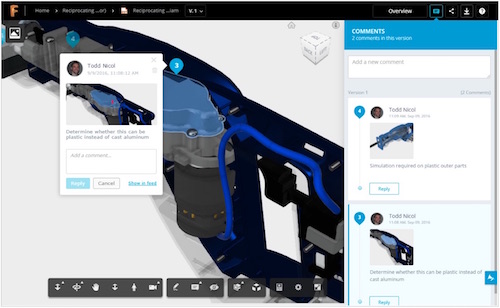Autodesk Rounds Out Fusion Lifecycle With Cloud-Based PDM

Autodesk’s new cloud PDM capabilities support real-time design reviews and viewing and markup of 3D files. Image Courtesy of Autodesk
Latest News
September 16, 2016
Autodesk was one of the first major vendors to push product lifecycle management (PLM) capabilities to the cloud, now it’s launching product data management (PDM) capabilities in the cloud, staking claim to be the first to offer an end-to-end cloud-based PLM platform.
At this week’s Accelerate 2016 conference in Boston, the vendor released cloud-based PDM as part of Fusion Lifecycle, as it dubs its product innovation platform. The unified offering comprises Fusion 360, Autodesk’s CAD, CAM, and simulation cloud-based functionality; Fusion Lifecycle for PLM, its initial PLM toolset, which includes new production introduction (NPI) quality management, change management, and bill of materials functionality; and Fusion Connect, its Internet of Things (IoT) data management platform born from its acquisition of SeeControl. Soon to join the Fusion Lifecycle platform will be Fusion Configure, enterprise CPQ (configure, price, quote) functionality based on last year’s acquisition of Configure One.
 Autodesk’s new cloud PDM capabilities support real-time design reviews and viewing and markup of 3D files. Image Courtesy of Autodesk
Autodesk’s new cloud PDM capabilities support real-time design reviews and viewing and markup of 3D files. Image Courtesy of AutodeskWhen it first announced its cloud PLM play back in 2012, Autodesk held back on delivering PDM capabilities (relying instead on its Vault on-premise PDM system) because of customers’ reluctance to put design IP into the cloud due to security concerns. But the bigger reason had more to do with performance given the ample size of 3D CAD models and the potential performance limitations related to bandwidth, according to Brian Roepke, Autodesk’s director of engineering.
“It had to do with the heaviness of CAD data—there are a lot of big files—and how to get performance right,” Roepke explains. “We had to look at how to make the performance fast enough to make it useable, which required new innovations and rethinking PDM.”
 The new PDM functionality is built directly into Fusion Lifecycle and is included at no additional cost to subscribers. Image Courtesy of Autodesk
The new PDM functionality is built directly into Fusion Lifecycle and is included at no additional cost to subscribers. Image Courtesy of AutodeskWhile Roepke tread lightly on revealing Autodesk’s secret sauce, he says the innovation makes use of some acquired technology that does some unique things in the area of data transfer. Calling the capability “transfer avoidance,” he says the technology employs compression technology and algorithms to figure out what data is necessary to send to the cloud—resulting in a reduction of data transmission by up to 70% in some cases.
“We don’t want time and latency related to what’s happening in the Internet transfer to get in the way of CAD performance,” he explains. “We look at each individual CAD file at a binary level and strip out the parts that have changed and send that to the cloud.” The more data transported to the cloud, the smarter the system gets in terms of weeding out what’s necessary to upload and what isn’t, he adds.
The new PDM functionality, available immediately, supports real-time design reviews, viewing and markup of 3D files, and connecting key processes for managing Bill of Materials (BOM) and Engineering Change Orders (ECOs).
In another a related announcement, Autodesk revealed a partnership with Nutonian, a maker of predictive analytics capabilities, which will be integrated with the Fusion Connect IoT (Internet of Things) component. In a future release, Nutonian’s AI modeling engine will be tapped to automatically mine large data sets from IoT products, allowing manufacturers to accurately forecast product equipment failure and offer preventive maintenance services as a way to grow revenue streams.
 The addition of Nutonian’s predictive analytics to IoT deployments could prevent manufacturers from hiring a data scientist, saving a $113,000 annual salary. Image Courtesy of Autodesk
The addition of Nutonian’s predictive analytics to IoT deployments could prevent manufacturers from hiring a data scientist, saving a $113,000 annual salary. Image Courtesy of AutodeskThis video clip provides basic background on Nutonian and explains its vision for data analytics:
Subscribe to our FREE magazine, FREE email newsletters or both!
Latest News
About the Author
Beth Stackpole is a contributing editor to Digital Engineering. Send e-mail about this article to [email protected].
Follow DE





